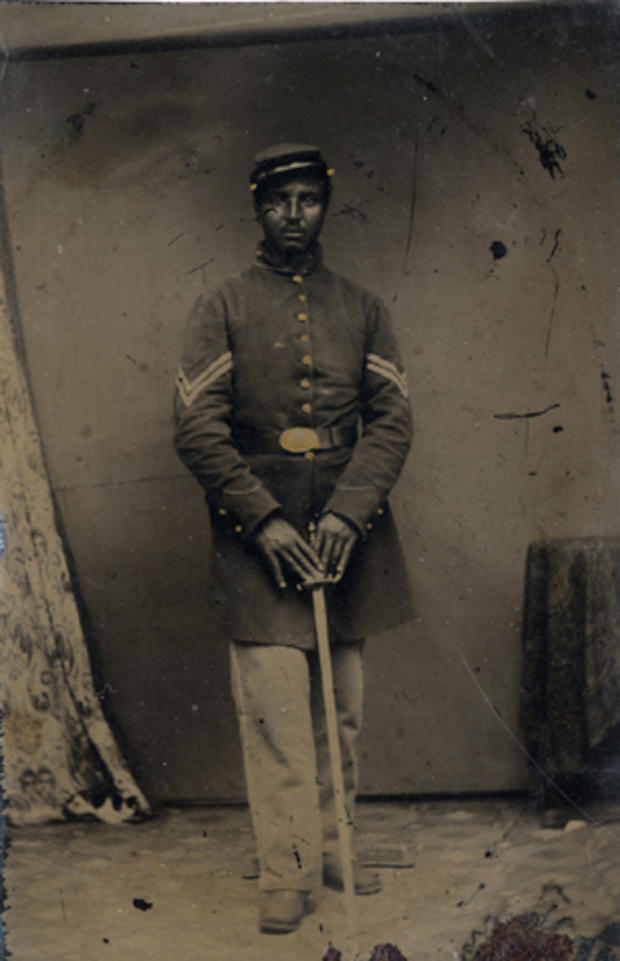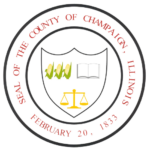African Americans in the Civil War
101 E. Main Street, Urbana, IL
In July 1862, President Abraham Lincoln and Congress authorized the use of African Americans as military combatants; however, they were not actually able to serve until after the Emancipation Proclamation took effect on January 1, 1863. Later the same year, Illinois Governor Richard Yates Sr. authorized the organization of the Illinois 29th Colored Infantry Regiment, better known as the 29th United States Colored Troops (USCT). Formed in Quincy, Illinois, on April 24, 1864, by Lieutenant Colonel John Bross, the 29th USCT was the only African American regiment raised in Illinois. The regiment was comprised of ten companies. Companies A through E were comprised primarily of men from Illinois, while companies F through K were mostly made up of men from outside the state. At least nine Black men from Champaign County enlisted into the 29th USCT at the Urbana Courthouse with four others enlisting in other “colored regiments” outside of Illinois.
From the Siege of Petersburg and the Battle of the Crater through Appomattox, the Illinois 29th USCT fought valiantly in the Eastern Theater of the war before being sent to Texas and most likely witnessing Union General Gordon Granger’s announcement of General Order No. 3, on June 19, 1865, proclaiming the state’s enslaved as free people. There, they served during the pacification of the state until they were ousted out. After the war and beyond, many of these returning soldiers and other African Americans who served during the Civil War and moved into the county were buried in the GAR portion of Mount Hope Cemetery in Urbana, Illinois, along with other county cemeteries.
After Lincoln and Congress authorized African American to fight in the Civil War, Illinois Governor Richard Yates Sr. gave the authorized to organize the Illinois 29th United States Colored Infantry Regiment. Known as the 29th United States Colored Troops (USCT), it was organized in Quincy, Illinois on April 24, 1864 by Lieutenant Colonel John A. Bross. The only African American regiment raised in Illinois. The regiment was comprised of ten companies. Companies A through E were comprised of primarily men from Illinois and were the first companies to be organized in April along with Company F which recruited men out of Wisconsin. Companies F – K were organized in October 1864, comprised of man outside of Illinois.
The regiment was present for the “trial by fire” on July 30, 1864, in the Battle of the Crater outside of Petersburg, VA. During the battle, the regiment suffered heavy casualties with 21 dead, including its original organizer, Lieutenant Colonel Bross. An additional fifty-six men were wounded and 47 went missing. Through early spring 1865, the regiment continued to see combat in the Petersburg Campaign. In the fall of 1864, they participated in the Battle of Weldon Railroad (known as the Battle of Globe Tavern) in August; the Battle of Peeple’s Farm (known as the Battle of Poplar Grove Church) in September; and the Battle of Boydton Plank Road in October. By early spring of 1865, they were holding the trenches at Chafin’s Farm and at Fort Barnham in the area. Then, on April 2, 1865, they participated in the assault that broke through the Confederates’ defenses. The Illinois 29th USCT marched into Petersburg singing “John Brown’s Body.” Following the campaign, the regiment was served on the Bermuda Hundred front north of Petersburg, and at Richmond. The Bermuda Hundred Campaign was named for the original plantation established in 1613 at the confluence of the James and Appomattox Rivers on which it was fought.
Their next action was in the Appomattox Campaign that ran from March 28–April 9, 1865. There, some regimental members witnessed the surrender of Robert E. Lee to Ulysses S. Grant at the Appomattox’s Courthouse. After the surrender came garrison duty in Virginia. Finally, in late May/early June, they and other African American troops were sent to Texas during the pacification of the state, the last stronghold of the Confederacy. They were witnesses to Union General Gordon Granger’s announcement of General Order No. 3, June 19, 1865, on Galveston Island, where the enslaved of Texas were for the first time told of their emancipation two years earlier. The date is now celebrated as Juneteenth. Being stationed at Corpus Christi, the Illinois 29th USCT patrolled along the Rio Grande River valley enforcing the new proclamation, subduing Confederate resistance and maintaining order until they were mustered out on November 6, 1865. They, along with other USCT troops, were procurers to the 9th and 10th Calvary and their two supporting infantry units known as the Buffalo Soldiers.
Several African Americans living in Champaign County, including farmers, tradesmen, and laborers, enlisted in the 29th Illinois USCT at the Champaign County Courthouse in Urbana. Others from the county traveled east to enlist in the 26th New York USCT and the Massachusetts 55th USCT, sister regiment to the famous 54th Massachusetts. The 54th USCT was noted as one of the first Colored Infantries organized after the Emancipation Proclamation at 1:01 a.m. on January 1, 1863. By the end of the Civil War, many African American veterans brought their families to Illinois and eventually settled in Champaign County.
Enlistees in the Illinois 29th include:
- John Clemens/Clements, Homer, Pvt. 29th USCT Illinois, Co. K. He was born in Tennessee, and died of disease on February 21, 1865, at sea.
- Payton Colwell, Champaign, Pvt. 29th USCT Illinois, Co. I. He died in New Orleans.
- Dennis Jackson, Champaign, 29th USCT Illinois. Enlisted February 15, 1865.
- David Johnson, Champaign, Wagoner, 29th USCT, Illinois. Enslaved on May 11, 1822, in Prince William County, Virginia, he was brought to Missouri by his owners, the Hose. He married Harriet Harbison in 1848 and had 13 children. David and Harriet later moved to Illinois, working on farms. In 1863, they arrived in Champaign where David appears to have joined the army as a wagoner. After the war, he worked as a laborer and married Anna Washington after his Harriet’s death. David died on November 9, 1908. Services were held at Second Baptist Church (Salem) and he was buried in Mt. Hope Cemetery in Urbana.
- George W. Johnson, Champaign, Pvt. 29th USCT, Illinois. Enlisted February 15, 1865.
- William Kelly, Champaign, Pvt. 29th USCT Illinois
- Samuel Persons, Homer, Pvt./Cpl./Sgt. 29th USCT, Illinois, Co. F; buried in Homer G.A.R. Cemetery.
- Jerry Pinney/Penney/Penny, Champaign, Pvt. 29th USCT Illinois. Enlisted February 15, 1865.
- James Walker, Champaign, Pvt. 29th USCT Illinois, Enlisted February 15, 1865. He was born around 1842 in Maryland. After the war, he worked as a laborer. He died on May 1, 1894, and was buried in Mt. Hope Cemetery in Urbana.
Enlistees in Infantries Outside of Illinois:
- Bryor Bell, Urbana, 26th USCT New York. Enlisted February 21, 1865.
- Thomas Benton, Champaign, 26th USCT New York. Enlisted February 21, 1865.
- Elijah Gibbs, Champaign, 55th USCT Massachusetts Vols., Co. H. Born around 1836 in Morgan County, Alabama, he came to Champaign County in 1861. After emancipation in 1863, he enlisted in the 55th After the war, he returned to Champaign and lived at the corner of 4th Street and University Avenue. He died on June 22, 1876, and was buried in Mt. Hope Cemetery.
- James S. Keines, Champaign, 26th USCT New York. Enlisted February 8, 1865.
African American Civil War Veterans who came to Champaign County after the Civil War:
- Jordan Anderson, Indiana, Pvt. 28th USCT Indiana Vol.; Member of local G.A.R. and buried in Mt. Hope Cemetery in Urbana.
- James H. Bell, — , Pvt. 29th USCT Illinois, Co. D. Born on May 1, 1847 he came to Champaign around 1865–67. He was a minister from 1872–1902 and died of tuberculosis on May 1, 1911. Services were held at Salem Baptist Church and was buried in Mt. Hope Cemetery in Urbana.
- William G. Blackburn, — , Pvt. 50th USCT Louisiana, Co. I; He died on January 20, 1893, and was buried in Mt. Hope Cemetery in Urbana.
- Isaac Beard, — , Pvt. 13th USCT Tennessee, Co. C; buried in Mt. Hope Cemetery in Sidney.
- J.C. Cone, — , Pvt. 54th USCT Massachusetts, Calvary; He was buried in Old Homer Cemetery.
- George W. Johnson, 118th USCT Maryland, Co. K; organized in Baltimore. He was born around 1831 in Missouri. While with the 118th, he participated in the siege of Petersburg and occupation of Richmond. After the war, he moved to Champaign and worked as a day laborer. He died on January 23, 1885, and he was buried in Mt. Hope Cemetery.
- John C. Lewis/Louis, Indiana, Sgt. Indiana 28th USCT, Co. In 1832, John was born in Canada. He came to Champaign-Urbana after the Civil War in 1865 and first worked as a plasterer. He married and had four children. He died of dropsy on September 17, 1886, and was buried in Mt. Hope Cemetery in Urbana.
- John R. Marrick, — , Pvt. 55th USCT Massachusetts Vols., Co. I. He was born around 1843 or 1844. After the war, he came to Urbana where he worked as a laborer. He was a member of the Black Eagle Post #129 of the GAR in Urbana. He died of pneumonia resulting from influenza on January 14, 1890, and was buried in Mt. Hope Cemetery in Urbana.
- Martin McDermot, — , 1st Class, Navy, 293-ton side Wheeler US Gunboat Hasting that carried eight guns, US Ouachita and US Clara Dolson on the Mississippi River. He served with the 60th Iowa USCT, known as the first Iowa African Infantry, in Company F. He enlisted on August 24, 1863.
- John Morse/Moss, — , Pvt. 55th USCT Massachusetts Vols., Co. H. Enlisted June 15, 1863, in Boston, Massachusetts; discharged August 29, 1865, in Charleston, South Carolina.
- Elijah Nelson, Tennessee, Pvt. 29th USCT Illinois; enlisted in Tennessee.
- Ruff Phillips, Missouri, Pvt. 48th USCT Missouri Vols., Co. C, and Drummer, 7th Illinois Calvary. After the war, he was employed for a time at John Moss’ barbershop. He died in Danville on February 16, 1879, and was buried in Mt. Hope Cemetery in Urbana.
- Jess (James) Edward Riley, Sr, Mississippi, Pvt. 29th USCT Illinois, Co. K. He was born in Wilkinson County, Mississippi, on March 16, 1834, and enlisted in Tennessee. After relocating to Champaign after the war, he worked as a laborer. By 1884, James became a barber residing with his family on the north side of University Avenue, four doors east of 4th Street. He died on June 14, 1892, and was buried in Mt. Hope Cemetery in Urbana. He had at least two sons, George, who attended the University of Illinois, and James Edward Jr.
- Stephen Roey/Roy, Tennessee, Pvt.. 110th Colored Reg. Alabama, Co. C. The 110th was organized out of the 2nd Alabama USCT. He was born in approximately 1842–45 in Tennessee. After serving during the war doing garrison and guard duty in Tennessee and northern Alabama, he moved to Champaign around 1873 and worked as a laborer. He died on August 13, 1893. Services were held at the Second Baptist Church (Salem) and was buried in Mt. Hope Cemetery in Urbana.
- Al Robinson/Robinson, —, 23rd USCT Virginia. The 23rd is noted for being the first African American infantry to fight in direct combat with General Robert E. Lee’s Army of Northern Virginia in 1864.
- Simon Ross, — , 49th USCT Louisiana, Co. K and I. While assigned to Co. I, he performed garrison duty at Vicksburg. He was born in South Carolina around 1830. After the war, he came to Champaign and worked as a laborer. He died on February 15, 1883, and was buried in Mt. Hope Cemetery in Urbana.
- Joseph Stocks, Vicksburg, MS, Sgt. 50th USCT Louisiana, Co. H. He was born on February 1, 1841, in Tensas Parish, Louisiana, and he enlisted on December 2, 1863. Enlisting as a private in Vicksburg after its fall to Union troops, Stocks was able to attain the rank of 1st Duty Sergeant. He saw action at Bruinsburg, Snyder Bluff, Fort Blakely, and Mobile. He sustained an eye wound at Fort Blakey and was hospitalized in Vicksburg and in Jackson, Mississippi. Stocks described a hard march from Florida to Mobile where the troops were on the verge of starving with nothing to eat but half cooked meat and parched corn. On one occasion, they had to wade through neck-deep water for more than a mile. He was discharged on March 20, 1866. He came to Champaign in 1894 and worked as a laborer until about 1906.
- George W. Smith, Tennessee, Scout.
- William Summerville, — , 29th USCT Illinois, Co. G; He is listed as a laborer and resident at 52 Park Street, Champaign, in 1885. He was buried in Mt. Hope Cemetery in Urbana.
- Larkin N/H. Walden, — , Pvt. 55th USCT Massachusetts Volunteers, Co. I. Born in Tennessee in 1830, he came to Champaign in 1865 as a laborer. He died on May 24, 1900, and was buried in Mt. Hope Cemetery in Urbana.
- James Walker, Maryland, Pvt. 118th USCT Maryland, Co. K. He was born in Maryland. He may had participated in the occupation of Richmond and served on the Rio Grande in Texas after the announcement of emancipation in Texas on June 19, 1865 (Juneteenth). After the war, he came to Champaign and worked as a day laborer. He died on May 1, 1894, and was buried in Mt. Hope Cemetery in Urbana.
- Stephen Winston, — , 110th USCT Alabama, Co. C. He died on May 4, 1900, and he was buried in Mt. Hope Cemetery in Urbana.
Other African American Civil War Veterans Buried in Champaign County:
- William P. Winn, — , Cpl. 18th USCT Missouri, Co. D. Winn was born in Tennessee around 1846 and after the war lived in Monticello, Piatt County, Illinois. He was buried in Mt. Hope Cemetery in Urbana.
This trail stop is sponsored by:
SOURCES:
“29th Regiment, United States Colored Infantry,” Military, website: https://military-history.fandom.com/wiki/29th_Regiment,_United_States_Colored_Infantry
Publication: From Salt Fork to Chickamaunga: Champaign County Soldiers in the Civil War, Chapter 22 “Black Soldiers in the Civil War,” by Robert H. Behrens [Urbana, IL: Urbana Free Library, 1988] pps. 371-381.
Article: Central Illinois Gazette, May 1, 1861. Discusses 32 free colored men who enlisted.
Article: “Honor for Colored Men,” Champaign County Gazette, September 13, 1899.
Decade:
1860-1869
People:
- Abraham Lincoln
- Samuel Persons
Additional Trail Sites


